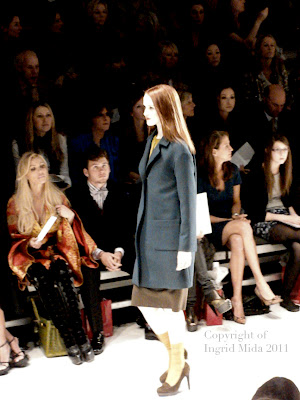 |
| LG Fashion Week Opening Night, Photo by Ingrid Mida 2011 |
Walking into an event like this, the red carpet looms not as a beacon of welcome but as the first test of whether or not one is fashionable enough to be photographed. From that moment on, the test continues inside and does not end until the night is over. Every set of heavily made up eyes gives you the once over from head to toe, making instant assessments of whether your shoes, outfit and handbag are sufficiently fashionable. You can feel them passing judgement, even if no words cross their collagen-injected lips and it takes a high degree of self-confidence and a good sense of humour to endure the non-stop scrutiny. I laughed my way through it with several glasses of champagne, a free makeover by L'Oreal and photo ops with some cute male models.
The next threshold to cross is the show venue itself. One is assigned either a seat or section, depending on your status and importance to the designer. A gift may or may not await you, depending on whether you are considered swag worthy and depending on whether or not your bag has been pilfered by those around you. Even getting to your seat can be like crossing a minefield, requiring the dexterity of a gymnast and the graces of a diplomat to pass by those engaged in air kisses and who-is- fabulous-now conversations.
It's all a relief when the show begins.... The reason I came is to see the artistry of the designers I admire. And yet, not everyone is looking at the runway; some are looking at who is looking at them!!! All too soon it is over, in a blur.
It is not all bad, but it is work to attend a fashion show and write about it. Making sense of what I've seen, culling through the good, bad and the ugly to define the trends and colours takes effort and it is easy to be distracted by the fashionable firestorm around me.
In the end, I am glad that I can hover close to the web of fashion but have a strong enough sense of self to not get wrapped up in it. Taking an academic approach to fashion suits me well. It fuels my art practice and I actually enjoy the hours I spend in the ROM and University of Toronto libraries conducting research. I don't have to dress up for this but I do anyway as an expression of my personality. I might not be one of the fabulous few, but I like who I am.
P.S. To read another perspective on this event, read this post Cinderella at the Ball by my clever and witty friend and neighbour Annie.







































